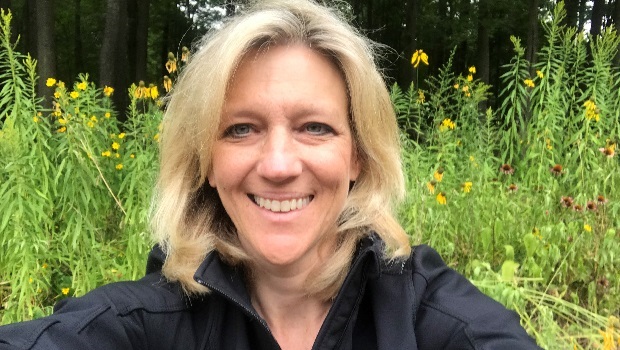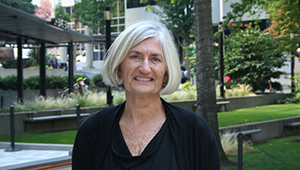How women are breaking academia’s glass ceiling

Dr. Amy Bonomi discusses her new book profiling 23 women who have risen to leadership positions in higher education and how they are changing their institutions
By Jordan Sims, summer communication intern, Kaiser Permanente Washington Health Research Institute
Less than a month after eagerly accepting my admission to the University of Southern California in 2018, I received an email from the university. I opened it, expecting to find move-in information, or perhaps a list of academic requirements. Instead, I was informed of allegations of sexual abuse by gynecologist George Tyndall, MD, who had practiced for years at the USC student health center, and the university’s concealment of his actions. Soon after, the USC president resigned, and Wanda Austin, PhD, was asked to lead the university on an interim basis.
I should have been thrilled—a woman, African American, and accomplished engineer as the interim president, marking the end of a 128-year era of white, male leaders.
So why did something feel off?
I found the answer to my question in Women Leading Change in Academia: Breaking the Glass Ceiling, Cliff, and Slipper when I reviewed it as part of my summer communication internship at Kaiser Permanente Washington Health Research Institute. It underscores that women leaders are disproportionately elevated to leadership positions when organizations are in crisis and their risk of failure is high—a phenomenon called the “glass cliff.” My uneasiness about the appointment of Dr. Austin, not a subject in this book, but a female academic leader nonetheless, arose from a fear that USC had potentially placed her on such a glass cliff.
Edited by Amy Bonomi, PhD, MPH, a researcher at Michigan State University and an affiliate investigator and former research associate at KPWHRI, and Callie Rennison, PhD, of University of Colorado Denver, the book shares the experiences of 23 diverse women academic leaders. While some conquered glass cliffs, others navigated leadership roles through routes that posed other obstacles. In compiling their narratives. Bonomi and Rennison have created a resource for women leaders, their allies, and the institutions they serve. It’s an enlightening and inspirational must-read.
To find out more about the book, which was published in August by Cognella Academic Publishing, I spoke recently with Dr. Bonomi, who also serves as director of the Children and Youth Institute at Michigan State University and on MSU’s Women’s Leadership Institute board.
You describe the creation of this book as “serendipitous.” Where did it all start, and why?
I was presenting on leading as a woman in academia at a national conference, where Callie Rennison, my co-editor, and I serve as senior mentors to emerging scholars in violence prevention and gender studies. I was describing being hired to lead a department in a glass-cliff scenario and the consequent resistance I faced. As director of her Title IX office, Callie identified with my experience and piped, “We need to write a book!” I thought Callie was just being emphatic in the moment, but when I got back to my laptop, she had already sent a follow-up email suggesting times for a meeting. And the rest is history!
Tell us more about this glass-cliff scenario you were hired into.
When I was recruited to MSU, large-scale change needed to happen in my department. Not surface-level change like “we need to drop two courses,” but “we need to completely redesign our approach to research to better align with the university’s mission and expectations.” In short order, as the department chairperson, I had to initiate a complete culture shift.
As women, should we accept positions that put us on glass cliffs?
Being in a glass-cliff scenario affords the potential to advance even more significant change than if you are brought into a situation where the organization is operating at the status quo and things are fine. So, in short, yes, take the job. Much creativity and innovation can come from leading in glass-cliff scenarios. But make sure you have supports in place. I had a professional network of other leaders that I used as a sounding board, and a core group of faculty committed to initiating the change. That was crucial to our success.
I was curious about your reference to the “glass slipper” in your title. Was this a joking Cinderella reference? Or a social phenomenon we should understand?
Both, actually! First, in the organizational literature, there’s the think-leader-think-male phenomenon, where people assume leadership traits like strong and competent belong to men. The think-leader-think-male phenomenon means people assume women aren’t qualified for leadership—but they are qualified to wear a glass slipper. Second, it’s a bit of Cinderella comic relief—I came up with the title to diffuse the reality of the painful glass ceiling and glass cliff.
How did you come across the women who contributed to your book? Did you pull from conferences you had been to, or just get out your laptops and go from there?
Our primary goal was to include women leaders from a range of diverse backgrounds. More than half of our contributors are from under-represented identity groups. We have both public and private institutions in 12 states represented, and we made sure to include women in various leadership roles, from presidents to emerging leaders.
We used a multifaceted strategy to identify leaders. We thought about innovative women leaders who we knew in our own universities and networks. And we also leaned on this fantastic collection of essays called Women and Power in the Academy, where 25 women had written about their experiences. I loved how Maggie Doherty’s essay began: “When it comes to ‘women and power in the academy,’ my first thought is: ‘We have none.’” We wanted to build on strong perspectives like that in our book.
What did you learn in editing this book?
I feel the entire book was a professional development opportunity. One of the important things we learned is the strength and solidarity that emanates from reading about the experiences of other women leaders. And that underscores the need for the book and for professional development opportunities that highlight the realities women face. In studying health interventions, we know one size doesn’t fit all, right? We need to apply this to professional development. An example would be if you’re teaching a seminar on negotiation for leaders in the academy. Instead of using a one-size-fits-all approach, you need to use case studies (maybe from this book!) that unpack what it would be like to be a black woman trying these negotiation strategies and the types of pushback that she might receive in a white majority culture. You need to recognize the different experiences of the people in your room.
As you know, KPWHRI has a new executive director, Dr. Rita Mangione-Smith. Are any ideas from the book particularly relevant to a woman taking over the reins of a research institute?
One of our contributors, Dr. Donde Plowman (recently appointed chancellor of the University of Tennessee, Knoxville), wrote a chapter on strategic planning and visioning. She likens strategic planning to a romance and explains it in this incredibly intuitive way. Think of the beginning of a romance—it’s edgy, exciting, and uncomfortable.
Strategic planning has to be the same way. She says that you don’t get people excited by saying, “Hey, come look at all my spreadsheets of data.” You get people excited when you use words like “I have a dream.” You know when you’re newly in love and it feels like you can do anything—you can go down a ski slope with no poles, you can conquer the world? Her point is that you have to convince your team they can conquer the world. And then she continues on with the other steps in a romance. I truly can’t do the chapter justice—you have to read it!
Your book highlights the importance of mentorship. What’s your takeaway for both mentors and mentees?
Whether mentor or mentee, I share the same advice: Regardless of time, place or setting, assume every individual (and sentient being, for that matter!) you encounter is a mentor, and see yourself as a mentor to all. Our thoughts, words, and actions matter deeply in every interaction.
This is difficult work. How do you keep things in perspective?
Having a really good peer network helps. And for me, yoga is a lifesaver. I started doing yoga in Seattle about 20 years ago, and since then it has given me something that, no matter how I am feeling, I can always go to. So I try to keep it a regular part of my life, even the days when I just don’t want to go because it’s a half-hour drive. And where I live really helps me find my peace. I live on an acreage with thick forest, rolling hills, and wildlife, so it makes for a great escape.
Now that that the book is completed, what’s next?
In talking about glass cliffs, one of our authors, Pat McGuire, the president of Trinity Washington University, said she loves being a “cliff dweller” because of the potential it gives her to do really innovative change. I just loved that. So I’ve been toying with the idea of writing a follow-up book called Cliff Dwellers. Perhaps I could solicit the narratives of women who are in these glass-cliff scenarios and the change they’ve achieved by virtue of their place.
healthy findings blog

In ‘Fifty Shades of Grey,’ portrayal of sexual abuse is black and white
Speaking with Business Insider, Dr. Amy Bonomi explains how the number-one box office hit clearly glorifies sexual violence.
CATALyST

Four CATALyST scholars selected to train as learning health system scientists
KP Washington joins forces with UW, WSU, and the VA to train scientists in transforming health care.
healthy findings blog

Don’t wait: Dr. Leana Wen urges public health action now
Dr. Paula Lozano shares inspirational moments from Dr. Leana Wen’s visit to Group Health. See short videos of Dr. Wen, with her full talk to come.
 Honoring Judith Schaefer: Patient champion and champion patient
Honoring Judith Schaefer: Patient champion and champion patient
Looking back on a career that reshaped how health systems tune in to the patient perspectives. Plus Judith's six habits for joyful work.


